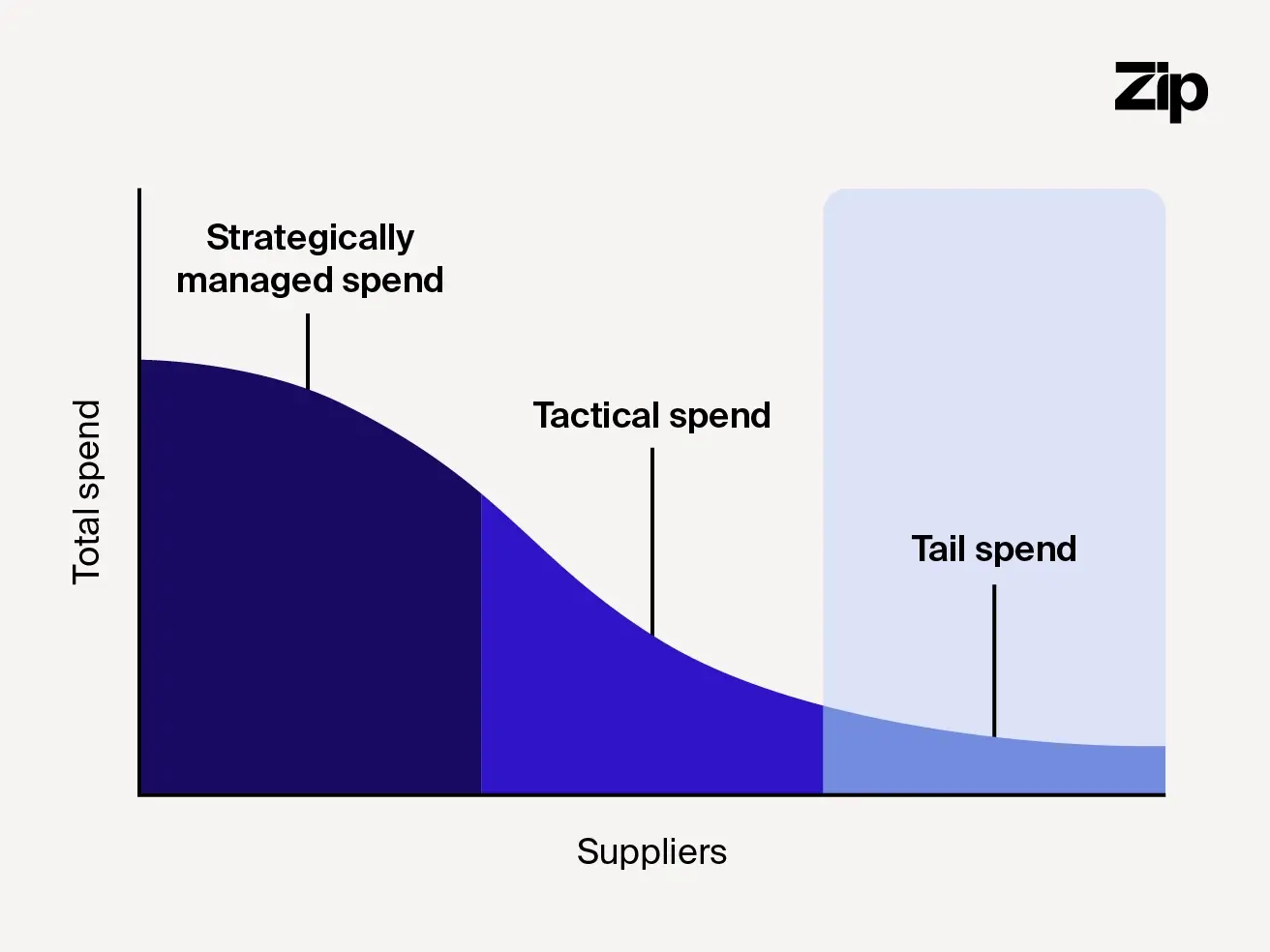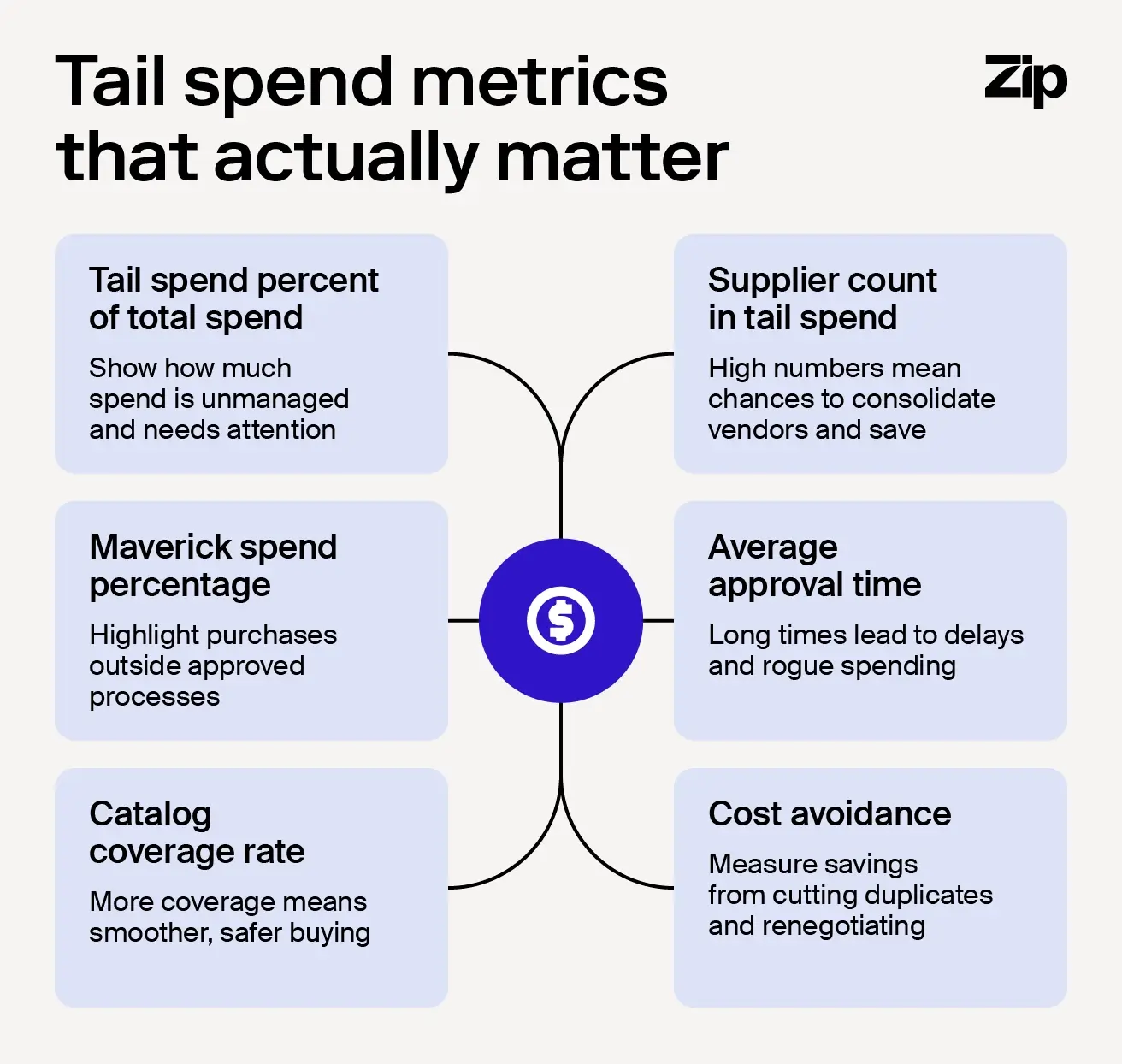
What is tail spend? Definition, examples, and management tips
Learn about tail spend, its benefits, and tools for effective management today.

Tail spend, the flood of small, scattered purchases that rarely hit anyone’s radar, gets expensive the moment budgets tighten.
For procurement teams, getting a grip on tail spend means better visibility, fewer rogue purchases, and more time to focus on strategic sourcing.
This guide gives you a clear definition of tail spend, a practical step-by-step breakdown for better tail management, and the tools that actually make it manageable. Let’s turn lost pennies into real profit.
Tail spend definition
Tail spend refers to the small, scattered purchases that fall outside of strategic procurement efforts. These are usually low-value, high-volume transactions made with vendors not regularly managed or tracked, often leading to missed savings and increased risk. It’s usually indirect goods and services including office supplies, software licenses, and quick fixes that get lost in the noise of more important business operations.
Even though tail spend makes up about 80% of all transactions, it only accounts for 10%-20% of total spend. That’s why it gets ignored. But those scattered purchases add up, and without visibility, they open the door to wasted money, compliance issues, and duplicate or outdated contracts.

How to manage tail spend
Tail spend management starts with visibility. You can’t control what you can’t see, so you first need to identify who’s buying what, from where, and why. Once you've got eyes on the data, you can start cleaning it up, cutting waste, and tightening your processes. Let’s take a look at tail management in procurement.
1. Define what counts as tail spend
Before you can manage tail spend, you need to know what it includes. Start by setting rules around what qualifies, like purchases under a certain dollar amount, vendors used fewer than a set number of times per year, or expenses made outside approved workflows.
For example, if a team bought a project management tool on a company card and the purchase wasn’t submitted for review, it didn’t go through the usual intake process. It might be small, but multiply that by dozens of similar tools across teams, and you’ve got real spend with zero oversight.
2. Fix the internal friction
Tail spend often happens because employees bypass procurement to save time. If the intake process is clunky or approval takes too long, employees will find workarounds like swiping a card or going straight to a vendor. These shortcuts create visibility issues and missed savings.
To fix this, make the purchasing process easier for everyone. Use tools that streamline intake and approvals without adding extra steps. Give teams a clear path to request what they need. When procurement works with employees, adoption goes up and tail spend goes down.
3. Clean and categorize your spend data
Once you’ve defined tail spend and smoothed out internal processes, the next move is to get your spend data in order. That means digging into your transactions, weeding out duplicates, correcting errors, and grouping similar purchases together.
Categorizing spend helps you see where money is leaking and which vendors or categories need attention. For example, grouping all office supplies or software subscriptions lets you spot patterns and opportunities to consolidate. Without clean, organized data, tail spend stays a confusing mess, making it nearly impossible to control.
4. Put insights into action
Cleaning and categorizing your spend data is only useful if you actually act on what you find. Use the patterns and gaps you discover to negotiate better deals, consolidate vendors, or eliminate unnecessary purchases. This is where tail spend turns from noise into real savings.
Set clear goals based on your data, whether it’s cutting costs by a certain percentage or reducing the number of vendors.
5. Track progress and tweak as needed
Managing tail spend isn’t a one-and-done deal. After putting your plan in motion, you need to keep an eye on the results. Monitor key metrics like savings achieved, vendor consolidation, and compliance rates to see what’s working and what’s not.
Use those insights to adjust your approach. Maybe you need tighter controls in one category or more training for a specific team. Staying flexible and responsive ensures your spend management keeps improving and delivers lasting value.

What are the benefits of well-managed tail spend?
By consolidating and controlling high-volume purchases, procurement teams can negotiate better deals, reduce risk, and boost efficiency. Key benefits include:
- Cost savings: When the procurement team controls small buys, you can negotiate better pricing and enforce consistent rates across the board. This stops suppliers from charging different prices for the same product and reduces overspending.
- Improved supplier relationships: Consolidated orders reduce supplier operational costs and paperwork. Streamlining purchase requests makes your business a preferred customer, which can lead to better pricing and priority during supply crunches.
- Increased productivity and efficiency: Cutting down on rogue outsourcing and supplier overload frees procurement teams to focus on high-value contracts. Automated approvals and better catalog coverage empower employees to handle purchases without bogging down procurement.
- Compliance and security: Standardizing tail spend prevents rogue suppliers and speeds up onboarding, reducing regulatory and cyber risks. Real-time tracking catches issues early, ensuring spending stays on-contract and employees follow policy.
- Improved stakeholder satisfaction: Clear processes and faster approvals mean employees get what they need without delays or confusion. Procurement teams spend less time firefighting and more time driving value, creating a smoother experience for everyone involved.
How AI intake automation streamlines tail spend control
AI-powered financial automation removes the burden of manual data entry by extracting key details directly from order forms. This cuts down on errors and speeds up requests, making the process smoother and reducing costly mistakes.
As employees fill out requests, the system offers real-time guidance, helping them pick the right categories, vendors, and justifications. This reduces back-and-forth and keeps requests aligned with procurement policies.
By enforcing compliance from the very first step, AI helps prevent off-contract or incomplete requests that create tail spend chaos. Catching issues early keeps spending visible, organized, and easier to manage.
Managing tail spend with Zip
Most companies know that tail spend is too big of a beast to conquer alone. Technology can open doors in terms of visibility, standardization, and efficiency. When done right, tail spend management strengthens supplier bonds, increases productivity, and gets compliance under control. All it takes is the right tool to manage it all.
Zip is an intelligent intake-to-procure platform designed to control spend and risk while supercharging employee adoption of your procurement process. From tail spend to total spend, Zip simplifies how a business buys and pays for the things they need to operate.
Ready to get started on your own tail spend management adventure? Zip can help guide the way. Sign up for a custom demo today.
Tail spend management FAQ
Still have questions about tail spend management? We’ve got you covered.
What are some examples of tail spend?
Tail spend can fall into several different categories and is often distributed across multiple business functions, like:
- Shipping: printing, packaging
- Marketing: social media management, web development
- Business services: IT, HR, etc.
- Office supplies: paper, snacks, equipment
- Signage and display: flyers, banners, signs
- Gifts and premiums: holiday gift baskets, company swag t-shirts
- Contractors: accounting, content writers, SEO
What are the most common challenges of tail management?
Tail spend is tricky because it’s scattered across many vendors and categories, often with low-value purchases that don’t get much attention. It’s hard to track and control when employees bypass procurement to save time, leading to rogue spending and inconsistent pricing. Plus, messy or incomplete data makes it tough to spot savings or risks early.
How can you reduce tail spend?
Here are a few ways to reduce tail spend in your organization:
- Start by gaining full visibility—know exactly what’s being bought, from whom, and for how much.
- Simplify and automate the intake process to reduce rogue buys and speed approvals.
- Consolidate vendors where possible and enforce compliance with clear policies and easy-to-use tools.
- Invest in trusted procurement software to keep tail spend visible and manageable.
- Review spend data regularly to catch leaks and keep tightening controls.

Maximize the ROI of your business spend

Enter your business email to keep reading



























.webp)



















.avif)













.avif)










.webp)





.avif)












.avif)
